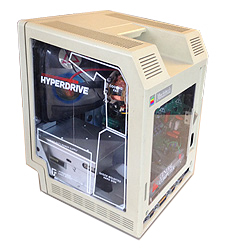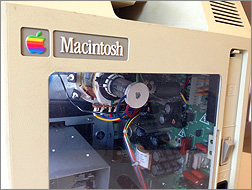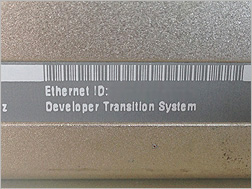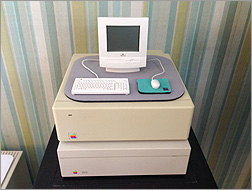Rare Items
Demo Units and Uncommon Collectibles
Apple Lisa 2
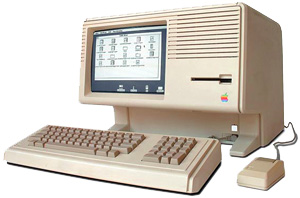 The Lisa is the predecessor to the Macintosh. Released in 1983, the Lisa was the first commercial computer which utilized the advanced concepts developed at Xerox PARC a decade earlier: the GUI (Graphical User Interface), icons, menus and the mouse. Apple’s seminal workstation launched the next chapter of computing, and utilized features like pre-emptive multitasking and protected memory that the Mac wouldn’t get for nearly twenty years. But the Lisa wasn’t a big seller, cost $10,000, and was ultimately superseded at Apple by the Macintosh – the computer for the rest of us.
The Lisa is the predecessor to the Macintosh. Released in 1983, the Lisa was the first commercial computer which utilized the advanced concepts developed at Xerox PARC a decade earlier: the GUI (Graphical User Interface), icons, menus and the mouse. Apple’s seminal workstation launched the next chapter of computing, and utilized features like pre-emptive multitasking and protected memory that the Mac wouldn’t get for nearly twenty years. But the Lisa wasn’t a big seller, cost $10,000, and was ultimately superseded at Apple by the Macintosh – the computer for the rest of us.
The VMM Lisa has an X/Profile Compact Flash adapter installed, to support running the Lisa OS long after the original Widget hard drive has given up the ghost. VMM Blog: At Last A Working Lisa! Mostly…
Clear Sided Mac 512k (HyperDrive Demo)
Before the Macintosh SE made its debut, there was no internal hard drive available for the compact Mac. Back in 1985 General Computer Corporation introduced the HyperDrive, an internal 10MB hard drive add-on. It wedged a 3.5-inch disk, power supply, logic board and fan inside the existing case, and was 7 times faster than Apple’s floppy-port based HD20. It also cost about the same price as the Macintosh itself, starting at nearly $2200 for the 512k – or $2800 for the 128k version, which upgraded you to 512K along the way.
This Mac model was a GCC trade show demo unit. The right and rear sides have been replaced by clear plexiglass panels, sporting graphics highlighting the HyperDrive components inside. It’s like a real world version of an engineering cutaway drawing! The hard drive and other electronics are long since gone, but the Mac is still working. This clear-sided beauty is a highlight of the Mac Museum’s collection.
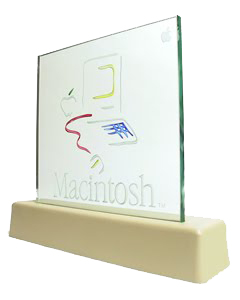
Macintosh “Picasso” Dealer Sign and Packaging Artwork
The famous Macintosh Picasso logo was developed for the introduction of the original 128k Mac back in 1984. A minimalist line drawing considered to be in the style of Pablo Picasso, this whimsical graphic implied the whole of a computer in a few simple strokes. During roll-out of the Mac Apple used this artwork for manuals, software, packaging, etc.. They also produced a limited edition promotional sign for original Mac dealers, that has the Picasso line art along with the name Macintosh etched into a 10″ x 10″ piece of glass. Manually beveled and painted, the glass was mounted on a beige plastic base containing an internal fluorescent light, illuminating the glass from below.
Today these signs and original packaging using the Picasso artwork are popular on the Apple collectibles market. Ironically in 2014 the designer of this artwork, John Casado, revealed that it was actually Matisse, not Picasso, who was his primary inspiration for this graphical style!
VMM Blog: The Enduring Appeal of Macintosh Picasso Artwork
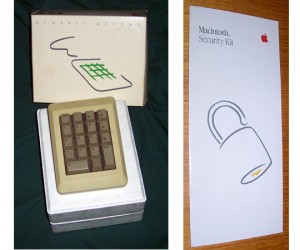 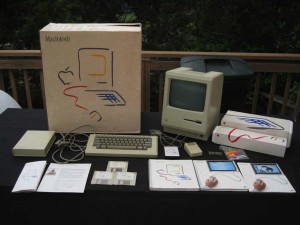 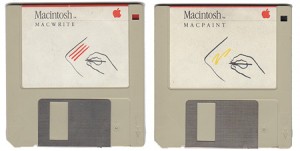 |
Outbound Notebook
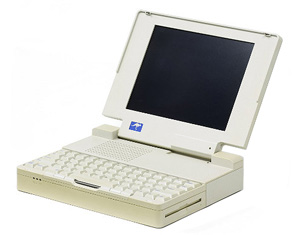 The Macintosh Portable was Apple’s first entry into the notebook market, but it’s high price and hefty weight were obstacles to market success. Before the Luggable was replaced by the PowerBook several third party options appeared, including the Outbound Notebook. An early Mac clone produced under agreement with Apple, it required a genuine Macintosh ROM pulled from a working Mac Plus or SE. But even with that extra cost, the Outbound was nearly half the price of Apple’s offering ($3500 vs $6500), smaller, lighter and faster. Business users were pleased.
The Macintosh Portable was Apple’s first entry into the notebook market, but it’s high price and hefty weight were obstacles to market success. Before the Luggable was replaced by the PowerBook several third party options appeared, including the Outbound Notebook. An early Mac clone produced under agreement with Apple, it required a genuine Macintosh ROM pulled from a working Mac Plus or SE. But even with that extra cost, the Outbound was nearly half the price of Apple’s offering ($3500 vs $6500), smaller, lighter and faster. Business users were pleased.
A unique feature of the Outbound was its pointing device, the TrackBar. Rather than a trackball or a trackpad, users slid their fingers left and right on a touch sensitive bar, which also rolled forward and backward, to move the cursor onscreen. Quite clever. And despite the kangaroo logo and down-under company name, Outbound Systems was actually located in Colorado, not Australia.
VMM Blog: An Outbound Notebook Comes In From the Cold
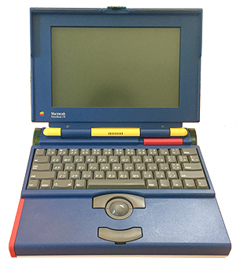
JLPGA PowerBook 170
In 1992 Apple manufactured approximately 500 multi-colored PowerBook 170 models to commemorate the Japanese Ladies Professional Golf Association (JLPGA) tournament. The JLPGA PB170 has the same innards as a standard 170, its rarity derives from the color case and that fact that only a small number were made. Replacing the standard battleship grey components are a dark blue palmrest and screen bezel, white top and bottom panels, yellow hinges, red sliding panels and green rotating feet. It is similar to the multicolor Apple logo color scheme and is really quite striking in appearance.
Also unique about this PowerBook is the Japanese keyboard. This was a promo item for the Japan so you don’t often see these keyboards outside that region. VMM Blog: A Rare Beast Captured: the JLPGA PowerBook 170
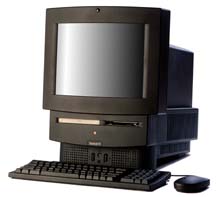
Macintosh TV
A black Mac! The Macintosh TV was a limited edition Performa 500 series all-in one, clad in a black case and including a TV tuner card. A Control Panel or supplied infrared remote control switched the whole screen between the Mac’s desktop, the TV tuner or a composite video input – no video-in-a-window on this puppy. Nothing the Performa couldn’t do, but Apple offered very few black machines during this period (or since) in North America (they were more popular in Europe), and it looked very cool! Unfortunately it was ahead of its time, and underwhelming performance plus slow sales led to a short lifespan. It has since become a desirable collector’s model.
At the VMM a Mac TV is connected to a DVD player running a loop of Apple TV commercials and demos.
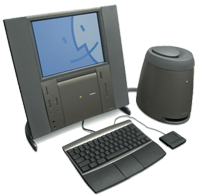
Twentieth Anniversary Macintosh (TAM)
To commemorate the twentieth anniversary of Apple Computer, the company decided to release a special edition Macintosh. This limited edition model was Apple’s vision of the future, a flat panel screen design with a vertical computer behind the screen. It included advanced AV capabilities like an FM/TV tuner and a custom Bose sound system, but with a $7500 price tag even home delivery by a tech-in-a-tux wasn’t enticing enough to attract buyers. The price of the computer dropped to as low as $1995 before Apple pulled the plug a year later.
Today the TAM has become a coveted collector’s item, and in retrospect was the predecessor to later iMacs. It is an early Jony Ive product, one created before Jobs returned to Apple. VMM Blog: And a TAM Joins the Family
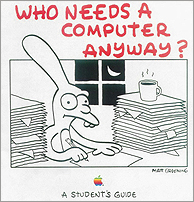 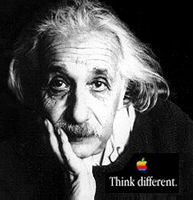 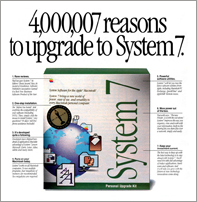 |
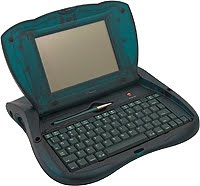
Apple eMate (Newton)
Shortly before the Newton’s demise Apple released the eMate, a small laptop (sub-notebook in modern parlance) designed for the education market. Colored Newton green, the eMate had a full QWERTY keyboard, a back-lit touch screen (stylus based), an expansion slot, AppleTalk networking capabilities, and a sturdy, appealing design. It ran the Newton OS, not Mac OS, and was a task-based portable computer well suited for note-taking, drawing, record keeping, etc.. The eMate was not a big commercial success, but its curvy shape, carrying handle and translucent plastics (another Jony Ive touch) influenced the designs of the colored iMacs and iBooks a few years later.
In the VMM the eMate is a perennial favorite. Many visitors to the Museum gravitate to this system, intuitively understand how to use it, and comment that it’s a cool little computer. Not bad for a vintage relic! VMM Blog: eMate Still a Crowd Favorite
Gemini iBook (Assistive Technology)
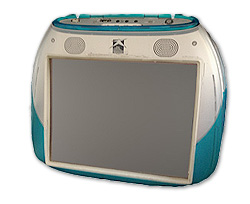 Touchscreen computers using a tablet form factor have been around for a long time, and work well as assistive technology devices used by the disabled. A decade before the iPad, a clamshell iBook G3 was married with a touchscreen to create this fully functional tablet Macintosh. The (now defunct) company Assistive Technology produced these systems back in 2001. The screen and keyboard of the iBook were replaced with an embedded touch sensitive display panel, and a small peripheral interface board along the top edge of the computer sports a USB port, a mini-joystick port, an input switch port, sound out and sound in ports. The iBook retains the ethernet port, modem, and CD-ROM drive. A popup keyboard (a la iOS) is used to type directly on screen, and speech recognition and speech synthesis software was included.
Touchscreen computers using a tablet form factor have been around for a long time, and work well as assistive technology devices used by the disabled. A decade before the iPad, a clamshell iBook G3 was married with a touchscreen to create this fully functional tablet Macintosh. The (now defunct) company Assistive Technology produced these systems back in 2001. The screen and keyboard of the iBook were replaced with an embedded touch sensitive display panel, and a small peripheral interface board along the top edge of the computer sports a USB port, a mini-joystick port, an input switch port, sound out and sound in ports. The iBook retains the ethernet port, modem, and CD-ROM drive. A popup keyboard (a la iOS) is used to type directly on screen, and speech recognition and speech synthesis software was included.
Cost of Gemini in 2001: $7500. Cost of iPad in 2014: $500. VMM Blog: Gemini iBook – a Mac OS 9 Tablet Mac
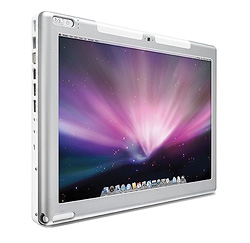
Axiotron Modbook
Six years after the Gemini iBook another company took a crack at making a tablet Mac, and this time for a wider audience. In 2007 Axiotron partnered with longtime Apple vendor OWC and introduced the Modbook, which took an Intel based MacBook and replaced the display with a touchscreen. Running OS X and offering a powerful computer in an elegant package, the Modbook defined the tablet Macintosh for several years – being, basically, the only entry.
In 2010 Apple introduced the iPad, and many predicted the Modbook’s demise. And indeed it did disappear for a few years, but reappeared in 2012 as the Modbook Pro, produced by a new company and using a 13″ MacBook Pro as the base system. There isn’t a large market for this kind of device, and it isn’t nearly as light or cheap as an iPad, but it’s still the only true OS X tablet in existence!
Apple Developer Transition System (Mac OS X Intel Migration)
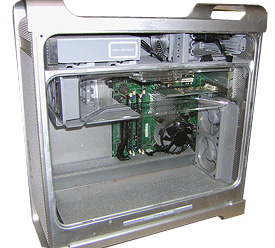 In 2006 Apple stunned the world (again) by announcing they were going over to the Dark Side: the Macintosh was going to switch to Intel processors. Apple had been secretly compiling Mac OS X on Intel chips ever since it’s evolution from NeXTstep, and the G5 marked the end of the line for the PowerPC Macintosh. To allow developers to prepare their software for the change, Apple provided special Macs with Pentium-based motherboards inside PowerMac G5 cases for testing purposes. Called Developer Transition Systems (DTS), these Trojan horse “PowerMacs” came with a special developer version of Mac OS X 10.4.1 for Intel and were leased, not sold, to developers. The mothership required all DTS units to be returned after one year, so very few of these hybrid Macs survive outside the gates of Cupertino.
In 2006 Apple stunned the world (again) by announcing they were going over to the Dark Side: the Macintosh was going to switch to Intel processors. Apple had been secretly compiling Mac OS X on Intel chips ever since it’s evolution from NeXTstep, and the G5 marked the end of the line for the PowerPC Macintosh. To allow developers to prepare their software for the change, Apple provided special Macs with Pentium-based motherboards inside PowerMac G5 cases for testing purposes. Called Developer Transition Systems (DTS), these Trojan horse “PowerMacs” came with a special developer version of Mac OS X 10.4.1 for Intel and were leased, not sold, to developers. The mothership required all DTS units to be returned after one year, so very few of these hybrid Macs survive outside the gates of Cupertino.
This DTS is in working condition but does not have a copy of 10.4.1 for Intel. A previous owner had used the tower as a (shudder) Windows XP machine and erased the Apple development software. Noooooo!!!! If anyone has a copy of Mac OS X build 8b1025, please contact me. (Update: software has been located.)
Historical note: the leaking of this early Tiger on Intel release spawned the birth of the Hackintosh. VMM Blog: Apple DTS – a Trojan Horse PowerMac

